
Parkinson’s disease is a chronic, progressive neurological disorder that affects millions of people worldwide. It is characterized by the degeneration of nerve cells in the brain that control movement, leading to symptoms such as tremors, stiffness, and difficulty with balance and coordination. While there is currently no cure for Parkinson’s disease, there is a growing body of research focused on health promotion and disease prevention strategies. This article explores the latest insights into preventing Parkinson’s disease, managing its symptoms, and promoting overall health for those affected by this condition.
Understanding Parkinson’s Disease
Before delving into prevention and health promotion, it is crucial to understand what Parkinson’s disease is and how it affects the body. Parkinson’s disease primarily impacts the brain’s neurons that produce dopamine, a neurotransmitter involved in regulating movement and coordination. As these neurons deteriorate, symptoms gradually emerge and progress over time.
Causes and Symptoms
The exact causes of Parkinson’s disease remain largely unknown, but research has identified several risk factors, including genetic predisposition, environmental factors such as exposure to pesticides, and the consumption of dairy products. Symptoms vary among individuals but commonly include tremors, slow movement, stiffness, and balance problems. Understanding these causes and symptoms is the first step in developing effective prevention strategies.
Disease Prevention and Health Promotion
Promoting health and preventing disease in the context of Parkinson’s involves a multifaceted approach that addresses physical activity, environmental exposures, and public health initiatives.
Physical Activity and Exercise
Regular physical activity is paramount in preventing Parkinson’s disease and managing its symptoms. Exercise has been shown to improve motor function, balance, and quality of life in people with Parkinson’s. It can also have neuroprotective effects, potentially slowing the progression of the disease. Incorporating exercises that focus on flexibility, strength, and aerobic fitness is beneficial for those at risk of or living with Parkinson’s.
Environmental Factors and Dietary Choices
Emerging research suggests that environmental factors, such as exposure to pesticides and the consumption of certain dairy products, may increase the risk of developing Parkinson’s disease. Limiting exposure to these risk factors and making informed dietary choices can be effective strategies for prevention. Public health campaigns and patient education can play crucial roles in raising awareness about these environmental risk factors.
Chronic Disease Prevention and Patient Education
Preventing Parkinson’s disease goes hand in hand with broader efforts to prevent chronic diseases. This includes promoting a healthy lifestyle, reducing exposure to environmental toxins, and encouraging regular health check-ups. Patient education is critical in this context, as informed individuals are better equipped to make choices that reduce their risk of Parkinson’s and other chronic conditions.
The Role of Research and Public Health
Research into Parkinson’s disease is vital for developing new prevention strategies and treatments. Studies investigating the genetic and environmental causes of Parkinson’s are particularly important, as they can lead to targeted interventions. Public health initiatives that focus on reducing exposure to known risk factors and promoting healthy lifestyles are essential components of disease prevention.
The Importance of Early Detection
Early detection of Parkinson’s disease can significantly impact the effectiveness of treatment and management strategies. Public health campaigns should emphasize the importance of recognizing early symptoms and seeking medical advice promptly. Increased awareness and education about the early signs of Parkinson’s can lead to earlier diagnosis and improved outcomes for those affected.
Integrating Mental Health Support
Addressing Mental and Emotional Well-being
Parkinson’s disease is not just a physical challenge; it also has profound mental and emotional implications. Anxiety, depression, and cognitive decline are common among those affected. Integrating mental health support into treatment plans is crucial. This includes counseling, support groups, and sometimes medication to manage the psychological aspects of the disease. Raising awareness and reducing stigma around the mental health challenges associated with Parkinson’s is vital for comprehensive care.
Leveraging Technology for Better Care
Digital Health Innovations
Technology plays a pivotal role in advancing Parkinson’s disease prevention and care. Wearable devices, mobile health apps, and telemedicine are revolutionizing how symptoms are monitored and managed. These technologies can track movements, provide reminders for medication, and even offer virtual physical therapy sessions. They enable personalized care, improve adherence to treatment plans, and enhance the quality of life for patients.
Building a Supportive Community
The Power of Collective Efforts
The journey with Parkinson’s disease is not one to be walked alone. Building a supportive community—comprising family, friends, healthcare professionals, and fellow patients—is invaluable. Community support can provide emotional encouragement, practical advice, and a platform for sharing experiences and coping strategies. Advocacy groups and online forums also play a crucial role in connecting people, fostering a sense of belonging, and empowering individuals to advocate for better care and research funding.
Nutritional Interventions for Parkinson’s Prevention
Emphasizing a Balanced Diet
Nutrition plays a critical role in the overall health of individuals, including those at risk for or living with Parkinson’s disease. A balanced diet rich in fruits, vegetables, whole grains, and lean proteins can provide essential nutrients that may help to mitigate some of the disease’s symptoms and potentially slow its progression. Antioxidant-rich foods, in particular, may offer neuroprotective benefits. This section would delve into specific dietary recommendations and how certain foods or supplements could influence the risk factors and symptom severity of Parkinson’s disease.
Innovations in Parkinson’s Disease Research
Exploring Cutting-Edge Treatments
The field of Parkinson’s disease research is rapidly evolving, with new discoveries and innovations offering hope for better treatments and possibly a cure in the future. This could include advancements in gene therapy, stem cell treatments, and novel pharmacological approaches targeting the underlying mechanisms of the disease. Highlighting ongoing studies and breakthroughs in treatment options can provide insight into the future of Parkinson’s disease management and the importance of continued investment in research.
Enhancing Quality of Life through Holistic Approaches
Integrating Complementary Therapies
Beyond traditional medical treatments, many individuals with Parkinson’s disease seek out complementary therapies to enhance their quality of life. This might involve practices such as acupuncture, massage therapy, yoga, or meditation. These holistic approaches can help manage symptoms, reduce stress, and improve emotional well-being. This section would explore the evidence supporting various complementary therapies and offer guidance on safely incorporating them into a comprehensive care plan for Parkinson’s disease.
Environmental Risk Reduction Strategies
Minimizing Exposure to Toxins
Exposure to certain environmental toxins has been linked to an increased risk of developing Parkinson’s disease. This section would focus on identifying common environmental hazards, such as pesticides and heavy metals, and providing practical advice on how individuals can reduce their exposure. Strategies might include choosing organic foods, using natural cleaning products, and advocating for environmental protection policies. Highlighting the role of environmental health in Parkinson’s prevention can empower individuals to make informed choices about their surroundings.
The Impact of Social Connections on Parkinson’s Disease
Strengthening Social Support Networks
Social connections and support networks play a crucial role in the well-being of people with Parkinson’s disease. This heading would explore how strong social ties can influence the course of the disease, impact mental health, and improve quality of life. It could also provide tips for building and maintaining these connections, whether through family, friends, support groups, or online communities. Emphasizing the value of social support, this section would offer insights into how being part of a community can provide emotional support, practical help, and a sense of belonging.
Advanced Diagnostic Tools for Early Intervention
The Future of Parkinson’s Detection
Early detection of Parkinson’s disease can significantly enhance the effectiveness of interventions and potentially slow the progression of symptoms. This section would delve into emerging diagnostic tools and techniques, such as advanced imaging technologies, biomarker research, and genetic screening. By highlighting the latest advancements in early detection methods, readers can gain an understanding of how these innovations could lead to more precise diagnoses, tailor treatments to individual needs, and ultimately improve patient outcomes.
Expanding further on the topic of Parkinson’s disease health promotion and disease prevention, here are three additional headings that would enrich the content:
Empowering Patients through Education and Resources
Fostering Informed Decision-Making
Education is a powerful tool in managing Parkinson’s disease. This section would emphasize the importance of patient education in understanding the disease process, treatment options, and lifestyle modifications that can support health and well-being. It would explore resources available for patients and caregivers, including workshops, online courses, and educational materials from reputable health organizations. By empowering patients with knowledge, they can become active participants in their care, making informed decisions that enhance their quality of life.
The Role of Sleep in Parkinson’s Disease Management
Understanding and Improving Sleep Quality
Sleep disturbances are common in individuals with Parkinson’s disease and can significantly affect their quality of life. This heading would address the challenges and strategies related to sleep in Parkinson’s disease, including the management of symptoms that disrupt sleep, such as restlessness and night-time awakenings. It would also cover the importance of good sleep hygiene practices and potential treatments for sleep disorders associated with Parkinson’s disease. Highlighting the connection between sleep and health can provide insights into holistic approaches for disease management.
Collaborative Care Models for Comprehensive Management
Integrating Multidisciplinary Teams
Parkinson’s disease management benefits significantly from a collaborative care approach, involving a team of healthcare professionals from various disciplines. This section would discuss the benefits of multidisciplinary care teams, including neurologists, physical therapists, occupational therapists, speech therapists, and mental health professionals, in providing comprehensive care. It would explore how these teams work together to address the complex needs of Parkinson’s patients, tailoring treatment plans to individual patients and ensuring continuity of care across the disease’s progression.
Conclusion
Parkinson’s disease remains a significant challenge, but through concerted efforts in health promotion, disease prevention, and research, progress is being made. Regular exercise, mindful dietary choices, reducing environmental exposures, integrating mental health support, leveraging technology, and building a supportive community are all key strategies



